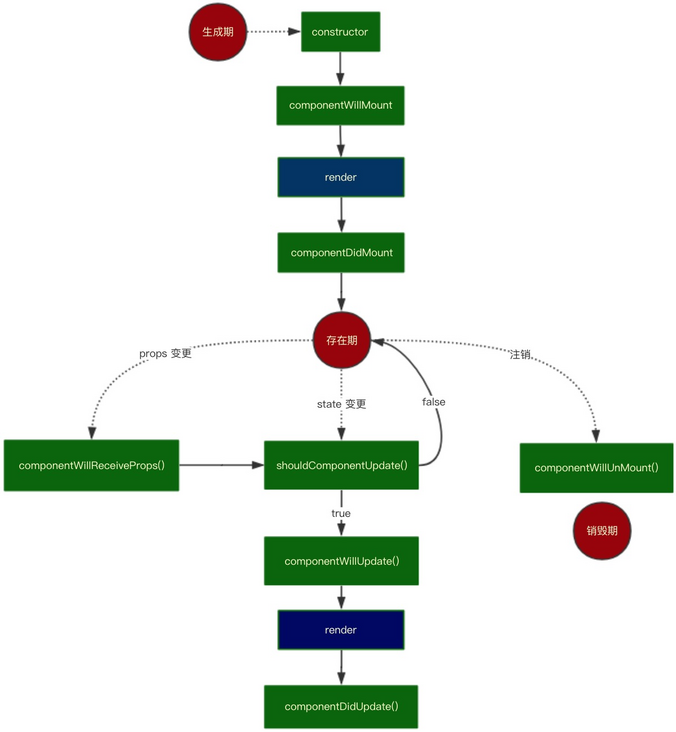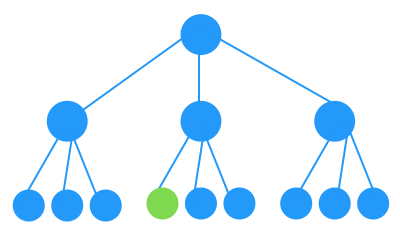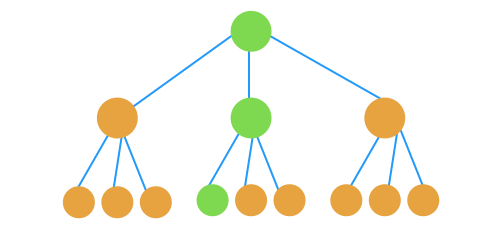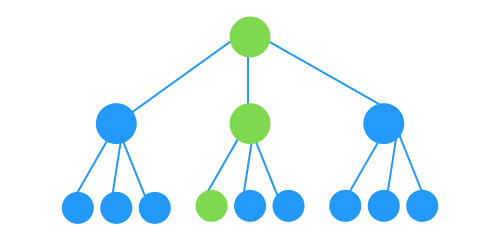[TOC]
# render什么時候會觸發

這張圖將react的生命周期分為了三個階段:生成期、存在期、銷毀期,這樣在create、props、state、unMount狀態變化時我們可以清楚的看到reacte觸發了哪些生命周期鉤子以及什么時候會render。
如果我們需要更改root的一個state,使綠色組件視圖更改

如果你寫過vue,你會發現組件更新是如上圖那樣的(視圖指令已編譯為修改視圖的函數存放在綁定的state里的屬性里,所以能夠做到靶向修改),而react會以組件為根,重新渲染整個組件子樹,如下圖(綠色是期望的render路徑,橙色是無用render):

所以在react里,我們探討的render性能優化是react調用render的路徑如下:

<br>
<br>
# 如何避免這些不必要的render:
## shouldComponentUpdate
~~~
shouldComponentUpdate(nextProps,?nextState)
~~~
使用shouldComponentUpdate()以讓React知道當前狀態或屬性的改變是否不影響組件的輸出,默認返回ture,返回false時不會重寫render,而且該方法并不會在初始化渲染或當使用forceUpdate()時被調用,我們要做的只是這樣:
~~~
shouldComponentUpdate(nextProps, nextState) {
return nextState.someData !== this.state.someData
}
~~~
## React.PureComponent
React.PureComponent 與 React.Component 幾乎完全相同,但 React.PureComponent 通過props和state的淺對比來實現 shouldComponentUpate()。如果對象包含復雜的數據結構,它可能會因深層的數據不一致而產生錯誤的否定判斷(表現為對象深層的數據已改變視圖卻沒有更新)
> 關注點:
* 無論組件是否是 PureComponent,如果定義了 shouldComponentUpdate(),那么會調用它并以它的執行結果來判斷是否 update。在組件未定義 shouldComponentUpdate() 的情況下,會判斷該組件是否是 PureComponent,如果是的話,會對新舊 props、state 進行 shallowEqual 比較,一旦新舊不一致,會觸發 update。
* 淺判等 只會比較到兩個對象的 ownProperty 是否符合[Object.js()](https://github.com/facebook/fbjs/blob/c69904a511b900266935168223063dd8772dfc40/packages/fbjs/src/core/shallowEqual.js#L39)判等,不會遞歸地去深層比較---[源碼](https://github.com/facebook/fbjs/blob/c69904a511b900266935168223063dd8772dfc40/packages/fbjs/src/core/shallowEqual.js#L39)
~~~
const hasOwnProperty = Object.prototype.hasOwnProperty;
/**
* inlined Object.is polyfill to avoid requiring consumers ship their own
* https://developer.mozilla.org/en-US/docs/Web/JavaScript/Reference/Global_Objects/Object/is
*/
function is(x: mixed, y: mixed): boolean {
// SameValue algorithm
if (x === y) { // Steps 1-5, 7-10
// Steps 6.b-6.e: +0 != -0
// Added the nonzero y check to make Flow happy, but it is redundant
return x !== 0 || y !== 0 || 1 / x === 1 / y;
} else {
// Step 6.a: NaN == NaN
return x !== x && y !== y;
}
}
/**
* Performs equality by iterating through keys on an object and returning false
* when any key has values which are not strictly equal between the arguments.
* Returns true when the values of all keys are strictly equal.
*/
function shallowEqual(objA: mixed, objB: mixed): boolean {
if (is(objA, objB)) {
return true;
}
if (typeof objA !== 'object' || objA === null ||
typeof objB !== 'object' || objB === null) {
return false;
}
const keysA = Object.keys(objA);
const keysB = Object.keys(objB);
if (keysA.length !== keysB.length) {
return false;
}
// Test for A's keys different from B.
for (let i = 0; i < keysA.length; i++) {
if (
!hasOwnProperty.call(objB, keysA[i]) ||
!is(objA[keysA[i]], objB[keysA[i]])
) {
return false;
}
}
return true;
}
~~~
<br>
## [react-immutable-render-mixin](https://github.com/jurassix/react-immutable-render-mixin)
我想復雜數組沒變化時也不要render(), 那你用[react-immutable-render-mixin](https://github.com/jurassix/react-immutable-render-mixin),來,我們看看插件的介紹:
> Users are urged to use PureRenderMixin with facebook/immutable-js. If performance is still an issue an examination of your usage of Immutable.js should be your first path towards a solution. This library was created from experimentations with Immutable that were ultimately erroneous; improper usage of Immutable.js ??. Users should be able to achieve maximum performance simply using PureRenderMixin.
>
> * * *
>
> 譯:不能以正確的姿勢來使用immutable-js做優化,你就不要瞎折騰了,用它react-immutable-render-mixin就行了
它和ProComponent原理一樣,唯一的區別就是新舊數據的對比,react-immutable-render-mixin用了[immutable-js](https://github.com/facebook/immutable-js)的is()方法去做對比,性能強,復雜類型數據也能對比(這里不對immutable-js做討論,一篇很不錯的文章[Immutable 詳解及 React 中實踐](https://github.com/camsong/blog/issues/3)),相比于React.PureComponent更方便---[源碼](https://github.com/jurassix/react-immutable-render-mixin/blob/master/src/shallowEqualImmutable.js)
<br>
<br>
# 參考資料
[react如何通過shouldComponentUpdate來減少重復渲染](https://segmentfault.com/a/1190000016494335)
- 第一部分 HTML
- meta
- meta標簽
- HTML5
- 2.1 語義
- 2.2 通信
- 2.3 離線&存儲
- 2.4 多媒體
- 2.5 3D,圖像&效果
- 2.6 性能&集成
- 2.7 設備訪問
- SEO
- Canvas
- 壓縮圖片
- 制作圓角矩形
- 全局屬性
- 第二部分 CSS
- CSS原理
- 層疊上下文(stacking context)
- 外邊距合并
- 塊狀格式化上下文(BFC)
- 盒模型
- important
- 樣式繼承
- 層疊
- 屬性值處理流程
- 分辨率
- 視口
- CSS API
- grid(未完成)
- flex
- 選擇器
- 3D
- Matrix
- AT規則
- line-height 和 vertical-align
- CSS技術
- 居中
- 響應式布局
- 兼容性
- 移動端適配方案
- CSS應用
- CSS Modules(未完成)
- 分層
- 面向對象CSS(未完成)
- 布局
- 三列布局
- 單列等寬,其他多列自適應均勻
- 多列等高
- 圣杯布局
- 雙飛翼布局
- 瀑布流
- 1px問題
- 適配iPhoneX
- 橫屏適配
- 圖片模糊問題
- stylelint
- 第三部分 JavaScript
- JavaScript原理
- 內存空間
- 作用域
- 執行上下文棧
- 變量對象
- 作用域鏈
- this
- 類型轉換
- 閉包(未完成)
- 原型、面向對象
- class和extend
- 繼承
- new
- DOM
- Event Loop
- 垃圾回收機制
- 內存泄漏
- 數值存儲
- 連等賦值
- 基本類型
- 堆棧溢出
- JavaScriptAPI
- document.referrer
- Promise(未完成)
- Object.create
- 遍歷對象屬性
- 寬度、高度
- performance
- 位運算
- tostring( ) 與 valueOf( )方法
- JavaScript技術
- 錯誤
- 異常處理
- 存儲
- Cookie與Session
- ES6(未完成)
- Babel轉碼
- let和const命令
- 變量的解構賦值
- 字符串的擴展
- 正則的擴展
- 數值的擴展
- 數組的擴展
- 函數的擴展
- 對象的擴展
- Symbol
- Set 和 Map 數據結構
- proxy
- Reflect
- module
- AJAX
- ES5
- 嚴格模式
- JSON
- 數組方法
- 對象方法
- 函數方法
- 服務端推送(未完成)
- JavaScript應用
- 復雜判斷
- 3D 全景圖
- 重載
- 上傳(未完成)
- 上傳方式
- 文件格式
- 渲染大量數據
- 圖片裁剪
- 斐波那契數列
- 編碼
- 數組去重
- 淺拷貝、深拷貝
- instanceof
- 模擬 new
- 防抖
- 節流
- 數組扁平化
- sleep函數
- 模擬bind
- 柯里化
- 零碎知識點
- 第四部分 進階
- 計算機原理
- 數據結構(未完成)
- 算法(未完成)
- 排序算法
- 冒泡排序
- 選擇排序
- 插入排序
- 快速排序
- 搜索算法
- 動態規劃
- 二叉樹
- 瀏覽器
- 瀏覽器結構
- 瀏覽器工作原理
- HTML解析
- CSS解析
- 渲染樹構建
- 布局(Layout)
- 渲染
- 瀏覽器輸入 URL 后發生了什么
- 跨域
- 緩存機制
- reflow(回流)和repaint(重繪)
- 渲染層合并
- 編譯(未完成)
- Babel
- 設計模式(未完成)
- 函數式編程(未完成)
- 正則表達式(未完成)
- 性能
- 性能分析
- 性能指標
- 首屏加載
- 優化
- 瀏覽器層面
- HTTP層面
- 代碼層面
- 構建層面
- 移動端首屏優化
- 服務器層面
- bigpipe
- 構建工具
- Gulp
- webpack
- Webpack概念
- Webpack工具
- Webpack優化
- Webpack原理
- 實現loader
- 實現plugin
- tapable
- Webpack打包后代碼
- rollup.js
- parcel
- 模塊化
- ESM
- 安全
- XSS
- CSRF
- 點擊劫持
- 中間人攻擊
- 密碼存儲
- 測試(未完成)
- 單元測試
- E2E測試
- 框架測試
- 樣式回歸測試
- 異步測試
- 自動化測試
- PWA
- PWA官網
- web app manifest
- service worker
- app install banners
- 調試PWA
- PWA教程
- 框架
- MVVM原理
- Vue
- Vue 餓了么整理
- 樣式
- 技巧
- Vue音樂播放器
- Vue源碼
- Virtual Dom
- computed原理
- 數組綁定原理
- 雙向綁定
- nextTick
- keep-alive
- 導航守衛
- 組件通信
- React
- Diff 算法
- Fiber 原理
- batchUpdate
- React 生命周期
- Redux
- 動畫(未完成)
- 異常監控、收集(未完成)
- 數據采集
- Sentry
- 貝塞爾曲線
- 視頻
- 服務端渲染
- 服務端渲染的利與弊
- Vue SSR
- React SSR
- 客戶端
- 離線包
- 第五部分 網絡
- 五層協議
- TCP
- UDP
- HTTP
- 方法
- 首部
- 狀態碼
- 持久連接
- TLS
- content-type
- Redirect
- CSP
- 請求流程
- HTTP/2 及 HTTP/3
- CDN
- DNS
- HTTPDNS
- 第六部分 服務端
- Linux
- Linux命令
- 權限
- XAMPP
- Node.js
- 安裝
- Node模塊化
- 設置環境變量
- Node的event loop
- 進程
- 全局對象
- 異步IO與事件驅動
- 文件系統
- Node錯誤處理
- koa
- koa-compose
- koa-router
- Nginx
- Nginx配置文件
- 代理服務
- 負載均衡
- 獲取用戶IP
- 解決跨域
- 適配PC與移動環境
- 簡單的訪問限制
- 頁面內容修改
- 圖片處理
- 合并請求
- PM2
- MongoDB
- MySQL
- 常用MySql命令
- 自動化(未完成)
- docker
- 創建CLI
- 持續集成
- 持續交付
- 持續部署
- Jenkins
- 部署與發布
- 遠程登錄服務器
- 增強服務器安全等級
- 搭建 Nodejs 生產環境
- 配置 Nginx 實現反向代理
- 管理域名解析
- 配置 PM2 一鍵部署
- 發布上線
- 部署HTTPS
- Node 應用
- 爬蟲(未完成)
- 例子
- 反爬蟲
- 中間件
- body-parser
- connect-redis
- cookie-parser
- cors
- csurf
- express-session
- helmet
- ioredis
- log4js(未完成)
- uuid
- errorhandler
- nodeclub源碼
- app.js
- config.js
- 消息隊列
- RPC
- 性能優化
- 第七部分 總結
- Web服務器
- 目錄結構
- 依賴
- 功能
- 代碼片段
- 整理
- 知識清單、博客
- 項目、組件、庫
- Node代碼
- 面試必考
- 91算法
- 第八部分 工作代碼總結
- 樣式代碼
- 框架代碼
- 組件代碼
- 功能代碼
- 通用代碼
